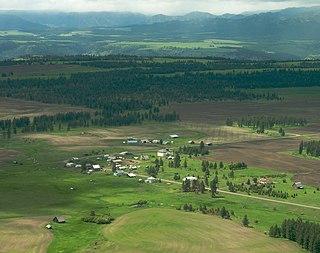In computer science, locality of reference, also known as the principle of locality, is the tendency of a processor to access the same set of memory locations repetitively over a short period of time. There are two basic types of reference locality – temporal and spatial locality. Temporal locality refers to the reuse of specific data, and/or resources, within a relatively small time duration. Spatial locality refers to the use of data elements within relatively close storage locations. Sequential locality, a special case of spatial locality, occurs when data elements are arranged and accessed linearly, such as, traversing the elements in a one-dimensional array.

This is a list of localities in Iceland. Most Icelandic municipalities consist of several cities or towns. For example, four localities can all be found in the municipality of Árborg.
In physics, the principle of locality states that an object is directly influenced only by its immediate surroundings. A theory which includes the principle of locality is said to be a "local theory". This is an alternative to the older concept of instantaneous "action at a distance". Locality evolved out of the field theories of classical physics. The concept is that for an action at one point to have an influence at another point, something in the space between those points such as a field must mediate the action. To exert an influence, something, such as a wave or particle, must travel through the space between the two points, carrying the influence.
.us is the Internet country code top-level domain (ccTLD) for the United States of America. It was established in 1985. Registrants of .us domains must be American citizens, residents, or organizations, or a foreign entity with a presence in the United States of America. Most registrants in the United States of America have registered for .com, .net, .org and other gTLDs, instead of .us, which has primarily been used by state and local governments despite any entity having the option of registering a .us domain.

Zhoukoudian or Choukoutien (周口店) is a cave system in suburban Fangshan District, Beijing. It has yielded many archaeological discoveries, including one of the first specimens of Homo erectus, dubbed Peking Man, and a fine assemblage of bones of the gigantic hyena Pachycrocuta brevirostris.

According to the Moldovan law on territorial administrative organisation, Moldova is divided administratively into the following administrative territorial units: districts, cities/towns and villages. The administrative territorial organization of Moldova is made on 2 levels:
- villages (communes), sectors and cities/towns (municipalities) constitute the first level,
- districts, Chișinău municipality, Bălți municipality and Bender municipality constitute the second level.
A post town is a required part of all postal addresses in the United Kingdom, and a basic unit of the postal delivery system. Including the correct post town in the address increases the chance of a letter or parcel being delivered on time. Post towns in general originated as the location of delivery offices. As of 2004, their main function is to distinguish between locality or street names in addresses not including a postcode.
An urban area or tätort in Sweden has a minimum of 200 inhabitants and may be a city, town or larger village. It is a purely statistical concept, not defined by any municipal or county boundaries. Urban areas referred to as cities or towns for statistical purposes have a minimum of 10,000 inhabitants. In 2010, there were 1,956 urban areas in Sweden, covering 85% of the Swedish population.
The classification system of the types of inhabited localities in Russia, the former Soviet Union, and some other post-Soviet states has certain peculiarities compared with the classification systems in other countries.

In geography, statistics and archaeology, a settlement, locality or populated place is a community in which people live. The complexity of a settlement can range from a small number of dwellings grouped together to the largest of cities with surrounding urbanized areas. Settlements may include hamlets, villages, towns and cities. A settlement may have known historical properties such as the date or era in which it was first settled, or first settled by particular people.
Suburbs and localities are the names of geographic subdivisions in Australia, used mainly for address purposes. The term locality is used in rural areas, while the term suburb is used in urban areas. Australian postcodes closely align with the boundaries of localities and suburbs.

MKB Nagar, also known as Maha kavi Bharathi Nagar, is mainly a residential locality in the northern part of the metropolitan city of Chennai, Tamil Nadu state, India. It was earlier known as Tamil Nadu Housing Board Colony until 1982.

Al-Hamraa is a village in northwestern Syria, administratively part of the Hama Governorate, located northeast of Hama. Nearby localities include Jubb al-Othman to the northeast, Abu al-Thuhur to the north, Fan al-Shamali to the west, Maar Shahhur to the southwest, Salamiyah to the south and Sabburah to the southeast. According to the Syria Central Bureau of Statistics (CBS), al-Hamraa had a population of 1,783 in the 2004 census. It is the administrative center and second largest locality of the al-Hamraa nahiyah ("subdistrict") which consisted of 44 localities with a collective population of 32,604 in 2004.

Mahrusah is a village in northern Syria, administratively part of the Hama Governorate, located west of Hama. Nearby localities include Jubb Ramlah to the north, Hanjur and Asilah to the northeast, Maarin to the east, Deir al-Salib to the southeast, Rabu to the south, Masyaf to the southwest and Deir Mama and al-Laqbah to the west. According to the Syria Central Bureau of Statistics, Mahrusah had a population of 6,579 in the 2004 census, making it the largest locality in the Jubb Ramlah subdistrict which consisted of 20 localities with a collective population of 39,814 in 2004. Its inhabitants are predominantly Alawites.









